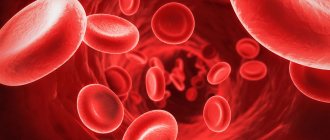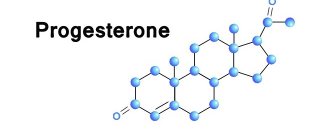- a hormone of steroid nature, which is synthesized in both female and, oddly enough, in male organisms. However, the role of progesterone in the body of the weaker sex is much higher, especially during pregnancy. It’s not for nothing that progesterone is called the pregnancy hormone.
Where is progesterone produced?
In women, progesterone is secreted mainly by the corpus luteum, a little by the adrenal glands, and during pregnancy by the placenta. In the first half of the menstrual cycle (about 14 days), the level of this hormone is relatively low. Further, during ovulation, one of the ovarian follicles turns into the corpus luteum, which actively synthesizes progesterone. During this period, women experience a slight rise in body temperature. If there was no conception, the corpus luteum gradually dissolves, progesterone synthesis decreases - menstruation occurs.
The role of progesterone during pregnancy
When a woman becomes pregnant, progesterone is produced for about 16 weeks. After which this function passes to the mature placenta. So what is progesterone responsible for in the body of a pregnant woman?
Functions of progesterone:
- prepares the mucous layer of the uterus for the embryo;
- reduces the willingness of the uterus to contract so that the fertilized egg is not rejected;
- adapts the nervous system of the expectant mother;
- affects the growth of the uterus;
- interrupts a new menstrual cycle when pregnancy occurs;
- prepares mammary glands for secretion;
- increases sebum production.
It follows from this that a significant deficiency of progesterone can not only lead to early miscarriage, but also make conception impossible altogether.
What other functions does progesterone perform?
It is important to know what the hormone progesterone is responsible for, in addition to maintaining pregnancy. First of all, it reduces the risk of tumor and pre-tumor diseases of the uterus (fibroids, endometriosis) and mammary glands. In addition, the hormone normalizes blood sugar levels and improves blood clotting, affects the exchange of calcium and microelements, and regulates blood pressure.
Almost all vital processes in the human body take place under the influence of hormonal substances synthesized in certain organs. One of the most important is the female sex hormone, progesterone. It is very necessary not only for the female, but also for the male body.
When determining a person’s hormonal level, questions are often asked: what is progesterone, why is it needed and how is it produced. This is a steroid type hormone, in other words, a substance produced by the body based on cholesterol.
The synthesis of progesterone, like other female sex hormones, occurs in the corpus luteum of the ovary.
Often, this steroid-type hormonal compound develops at the site of a ruptured follicle, which occurs during ovulation. In men, this hormone is produced in the seminal vesicle. In addition, the adrenal cortex and placenta play an important role in the formation of progesterone. The liver is the site of breakdown. Here the hormone is processed and broken down into a number of inactive biological substances.
The hormonal compound is responsible for a woman’s ability to conceive and the normal course of pregnancy.
An important function is that it allows you to feel the maternal instinct and reveals femininity. The substance prepares the epithelial tissue of the uterus for the attachment of a fertilized egg, prevents contractions of the muscles of the uterus, thereby preventing miscarriage and premature birth.
In addition, during pregnancy, menstruation stops precisely because of progesterone. Main functions during pregnancy - responsible for increasing the amount of sebum and uterine size, preparing the mammary glands for lactation.
The female hormone progesterone, or as it is also called the “pregnancy hormone,” can give moments of delight, sincere tenderness and joy at the sight of a baby.
It is this substance that prepares the body for pregnancy, bearing children and childbirth, caring for and raising offspring. The action of progesterone is aimed at programming the so-called “maternal instinct” and lays down responsibility towards one’s own children. Progesterone is involved in the production of male hormones, or androgens, and also participates, along with the adrenal glands, in the synthesis of corticosteroid hormones.
Amount of hormone
During the follicular period (during menstrual flow) progesterone is quite low. But during the period of ovulation, approximately in the middle of the cycle, its amount begins to increase. The luteal phase (the period of follicle rupture and egg release) is characterized by the highest levels of the hormone. From a physiological point of view, such periodic fluctuations in the level of the substance in women and girls of childbearing age are considered normal. In fact, this is how the body signals intensive preparation for procreation, conception and bearing children.
After fertilization of the egg and its attachment to the uterus for further development of the fetus, the content increases tenfold. First, the hormone is synthesized by the corpus luteum, then the placenta. The female hormone progesterone is necessary for the attachment of the embryo to the uterus and its proper intrauterine development throughout pregnancy. The level of the hormone constantly increases during pregnancy, and before childbirth there is a slight decrease.
Symptoms of progesterone deficiency
Since this substance is perhaps the “most feminine” hormonal compound, its deficiency affects not only the physical well-being, but also the emotional background of the fair sex. What are the symptoms of progesterone deficiency?
Among the signs the most noticeable are:
- Irregular menstrual cycle;
- Vaginal dryness and pain during intercourse;
- Chest pain;
- Dizziness, headaches, fainting;
- Bleeding from the genitals (not as profuse as during menstruation, more like spotting);
- Increased or decreased temperature;
- Excess of androgens (male sex hormones), expressed in loss of elasticity of the skin, excessive hair growth and increased secretion of the sebaceous glands;
- Sudden mood swings for no apparent reason (including aggression, irritability, despondency and even depression);
- Increased gas formation, bloating, constipation.
If you notice these manifestations, you should immediately make an appointment with a doctor, get diagnosed and receive adequate treatment in a timely manner.
What are the side effects of progestin?
The list of side effects of progestin includes:
- headache;
- breast tenderness or tenderness;
- upset stomach, vomiting, diarrhea, constipation;
- changes in appetite;
- excess weight
- fatigue;
- pain in joints, muscles or bones;
- mood swings or irritability;
- excessive worry;
- sneezing, cough, runny nose;
- problems with urination.
Taking progestins is also associated with rare but potentially dangerous side effects that may require medical attention. These include:
- breast tumors;
- clear or bloody discharge from the nipples;
- inverted or flat nipples;
- nipple curling or crusting;
- skin ripples on the chest;
- light stool;
- migraine pain;
- severe dizziness;
- slow speech or difficulty speaking;
- weakness or numbness of the limbs;
- lack of coordination;
- shortness of breath;
- strong heartbeat;
- sharp chest pain;
- coughing up blood;
- swelling of the legs;
- bulging eyes;
- double vision (diplopia);
- unexpected vaginal bleeding;
- uncontrolled squeezing of hands;
- apoplexy;
- stomach pain or swelling;
- depression;
- hives, skin rash and itching;
- difficulty swallowing;
- swelling of the face, throat, tongue, lips, eyes, hands, feet, ankles, legs;
- hoarseness
Diagnostics
If you notice symptoms and signs of progesterone deficiency, you should seek advice from a specialist. The doctor will order a test for hormonal substances. Today, this is the most accurate and effective way to diagnose such failures, allowing you to quickly determine the degree of criticality of the situation and the severity of the clinical picture.
When to donate blood for research?
The biomaterial is donated in the second half of the cycle, after ovulation. It is during this period that the concentration of progesterone reaches its maximum values. If your cycle is 28 days, then it is best to take the test on the 22nd or 23rd day. With a longer or shorter menstrual cycle, the period for testing is shifted by the corresponding number of days. If necessary, your doctor will help you calculate the date for your laboratory visit. Like other tests for hormones, biomaterial (blood) is taken early in the morning, on an empty stomach, at least 6-8 hours after the last meal.
In addition, in case of infertility or miscarriage, women may be prescribed a urine test. In this biological fluid you can find a breakdown product of progesterone - a metabolite.
Decoding analysis data
In women, depending on the period of the cycle, the normal level of progesterone levels varies and is:
- 0.32-2.24 nmol/l - in the follicular phase;
- 0.48-9.42 nmol/l - during ovulation;
- In the luteal phase – 7-56.64 nmol/l;
- In the 1st trimester of pregnancy - 8.8-468 nmol/l, in the 2nd - 71-303 nmol/l and, finally, in the 3rd trimester, before birth - 88-771.6 nmol/l;
- After menopause - less than 0.65 nmol/l.
The male body also synthesizes this substance. However, in the results of hormone tests, the progesterone indicator should be much lower than that of the fair sex: about 0.31-0.65 nmol/l.
If you use any medications, you should notify your doctor so that he can correctly interpret the test results. Any deviation in the percentage of progesterone in the blood from the norm, even upward, indicates that you have serious health problems. This means that it is necessary to take measures to normalize the level of the hormone.
Excess hormonal substance
An increased concentration of progesterone in some cases becomes an indicator that a woman is pregnant. In addition, in some cases, after taking certain pharmaceutical drugs, the level of this substance in the blood increases. Women should remember that sometimes any uterine bleeding (with the exception of menstruation) leads to excess progesterone. The same changes can be observed with severe renal failure.
Lack of progesterone after conception often leads to miscarriage in the 1st trimester of pregnancy. With a deficiency of this hormonal substance, ovulation is delayed. After this, more serious disruptions to the body’s functioning begin: prolonged and painful rejection of uterine tissue, which is almost always accompanied by painful and prolonged uterine bleeding.
The reasons may be long-term use of hormonal contraceptives, nervous or physical exhaustion, incorrect choice of diet, malfunction of any part of the neuroendocrine system, tumors, stress, lack of sleep. Diseases of the adrenal glands, liver, thyroid gland, pituitary gland or ovaries can lead to a lack of progesterone.
How to increase hormone levels
If you have been diagnosed with a lack of progesterone, you will have to increase its concentration in the blood to normal levels. Nowadays, pharmaceutical and pharmacological companies have developed special preparations of the female hormone progesterone based on its synthetic analogues.
Natural hormonal substances are used when the concentration of a hormone in the body decreases due to endocrine factors. Similar remedies are used for mastopathy, during menopause, for menstrual irregularities and for PMS. If there is a threat of miscarriage or miscarriage, the doctor can also prescribe natural hormones.
However, if you are wondering how to increase the female hormone progesterone, under no circumstances should you select medications and adjust your hormonal levels on your own. Effective treatment with a minimum of side effects can only be prescribed by a qualified specialist.
Progesterone (from Latin pro - before and English gesta(tion) - pregnancy) is a female hormone of the steroid group, a natural biological progestogen produced in women by the ovaries and adrenal glands, and during pregnancy - by the placenta. The main metabolic and physical effects of the hormone progesterone are related to the reproductive system.
In men, progesterone is produced in small quantities by the adrenal cortex and testicles.
During pregnancy, progesterone suppresses immune responses to prevent the rejection of a fertilized egg. When it is in excess, the immune system is suppressed, which results in susceptibility to infectious diseases.
The biosynthesis of the hormone progesterone occurs predominantly in the corpus luteum, which is formed after ovulation in the destroyed postovulatory follicle and is stimulated by follicle-stimulating (FSH) and luteinizing hormones (LH) of the pituitary gland. Under the influence of FSH, one of the follicles forms and begins to develop in the ovary, then the pituitary gland begins to secrete LH, causing ovulation. The follicle is destroyed and turns into the corpus luteum - a temporary endocrine tissue that functions for a certain time, and then undergoes luteolysis, stops its activity and regresses. With the onset of regression of the corpus luteum, the concentration of the hormone drops, the functional layer of the endometrium is rejected and menstruation begins.
The process of development and regression of the corpus luteum directly affects progesterone levels. In the follicular phase, its amount in the blood is minimal and amounts to 0.3–0.9 ng/ml; an increase occurs before ovulation. The maximum concentration is observed a week after the onset of ovulation; during the luteal phase, the hormone level rises to 15–30 ng/ml. Then the cycle repeats: the follicular phase begins, the hormone level decreases, the ovarian follicles begin to produce estrogens, and the functional layer of the endometrium is restored.
If conception occurs, the corpus luteum prolongs its existence and continues to secrete progesterone. During pregnancy, the biosynthesis of the hormone is stimulated by human chorionic gonadotropin (HCG), which prevents luteolysis and maintains the secretory activity of the corpus luteum. When the need for luteotropic stimulation disappears, the placenta takes over the function of hormone synthesis. The growth of the placenta causes an increase in the amount of circulating progesterone, its production continues to increase with each week of pregnancy and reaches 150 ng/ml by the third trimester.
In women, the concentration of the hormone fluctuates depending on the phase of the menstrual cycle, and in the case of pregnancy, on its duration.
Features of the functioning of the corpus luteum
During the follicular phase of the menstrual cycle, the dominant follicle matures. During this period, estrogens and follicle-stimulating hormone (FSH) play a decisive role. The latter, together with luteinizing hormone (LH), is secreted by the adenohypophysis. Without FSH, the effects of LH are impossible. Follicle-stimulating hormone provokes the formation of luteinizing hormone receptors on the surface of granulosa cells in the follicle. Without them, LH will not be able to have an effect on the ripening follicle.
The biological effects of LH are as follows:
- stimulation of androgen synthesis as estrogen precursors;
- activation of prostaglandins and proteolytic enzymes, which lead to follicle rupture;
- luteinization of granulosa cells, which form the corpus luteum;
- stimulation of progesterone synthesis from luteinized cells; prolactin works in synergy with LH.
The time when the luteal phase begins is considered to be the end of ovulation. A standard menstrual cycle lasts from 21 to 35 days, but the average is 28 days. The duration of each phase of the cycle is variable, but on average, 12-14 days pass from the first day of menstruation to ovulation. The duration of the luteal phase itself is also 12-14 days. After it ends, the cycle repeats again.
Follicle rupture occurs at the peak of luteinizing hormone secretion. The egg is released into the abdominal cavity and, under the vibration of the fimbriae on the terminal part of the appendages, penetrates the fallopian tubes. Fertilization should occur there within 12-24 hours. The viability of the egg is no longer maintained beyond this time.
In the burst follicle, the process of luteinization occurs. The cells of the granular membrane continue to multiply and grow, and a specific enzyme, lutein, accumulates in them, which gives them a characteristic yellow color. This is how a temporary endocrine gland is formed - the corpus luteum. The duration of its existence depends on the presence of pregnancy. If fertilization does not occur, then after 12-14 days the corpus luteum regresses.
The lifespan of the gland increases with pregnancy. The embryo forms various types of cells, one of which is the trophoblast layer. It is formed 4-5 days after fertilization. Trophoblast cells begin to secrete the hormone human chorionic gonadotropin (hCG), which maintains the corpus luteum and stimulates the production of progesterone. This process lasts until the placenta is formed, after which it takes over the function of the corpus luteum, and the gland gradually resolves.
Functions of progesterone
What is the hormone progesterone responsible for in women? This hormone is necessary to prepare the female body for the upcoming pregnancy and childbirth, which is why progesterone is called the pregnancy hormone.
The effect of progesterone on a woman’s body can be considered as preparing the female body for bearing a child:
- prepares the endometrium lining the uterus for implantation of a fertilized egg and ensuring the vital activity of the embryo;
- helps stabilize the swollen endometrium, preventing it from being rejected during pregnancy;
- blocks contractions of the uterine muscles - reduces the sensitivity of the uterine myometrium to physiological stimulants of contraction, which can lead to spontaneous abortion;
- helps in preparing the mammary glands for lactation - causes their engorgement, controls proliferation and glandular transformation of the alveoli, where milk is synthesized and secreted;
- increases the viscosity of mucus in the cervix - forms a barrier that helps prevent bacteria and other foreign agents, including sperm, from entering the uterine cavity from the vagina;
- suppresses the immune reactions of the maternal body to prevent embryo rejection - the fetus is not recognized as a foreign body and is not rejected;
- causes the growth of the uterus;
- strengthens the muscles of the cervix, protecting against premature birth;
- relaxes the muscles of the uterus, prepares the pelvic ligaments for relaxation during childbirth to ensure the expansion of the pelvic bones for the passage of the fetus through the birth canal at the time of birth;
- causes fluid retention in the body;
- affects metabolism in the body - increases the production of cortisol by the adrenal glands, increases the production of aldosterone, lowers the level of somatotropic hormone, reduces insulin sensitivity (stimulates the release of insulin from the pancreas in response to glucose entering the body), affects the body’s ability to accumulate fat, creates optimal conditions for the accumulation of glycogen in the liver.
Progesterone is capable of retaining fluid in the body; its excess can increase the permeability of peripheral veins and make their walls overly distensible. The liquid part of the blood passes from the vessels into the tissues, leading to the appearance of edema.
Progesterone breakdown products affect the nervous system and sleep, have a calming and analgesic effect.
High progesterone
Deviation of progesterone from the norm, especially long-term, can cause serious disorders in the body.
Excessive relaxation of ligaments and tendons with elevated hormone levels increases the risk of injury. Relaxation of the smooth muscles of the gastrointestinal tract leads to slower movement of food and dyspeptic disorders (fermentation of food in the intestines, increased formation of gases).
During pregnancy, progesterone suppresses immune responses to prevent the rejection of a fertilized egg. When it is in excess, the immune system is suppressed, which results in susceptibility to infectious diseases.
Progesterone is capable of retaining fluid in the body; its excess can increase the permeability of peripheral veins and make their walls overly distensible. The liquid part of the blood passes from the vessels into the tissues, leading to the appearance of edema.
The hormone stimulates the production of sebum, so its increase causes dermatological problems, especially acne.
The main metabolic and physical effects of the hormone progesterone are related to the reproductive system.
An excess of progesterone is characterized by the following symptoms:
- headache;
- intense weight gain;
- swelling;
- thromboembolism, thrombophlebitis;
- allergic reactions;
- frequent colds, exacerbation of herpes;
- digestive disorders;
- changes in blood pressure;
- visual disturbances (vascular lesions of the retina, double vision);
- intermenstrual bleeding;
- engorgement and tenderness of the mammary glands;
- inflammation of the sebaceous gland ducts, oily seborrhea.
High progesterone indicates abnormalities in the body. Among the diseases that can lead to an increase in its level are neoplasms of the reproductive system and adrenal glands, dysfunction of the adrenal cortex, corpus luteum cyst, diseases accompanied by uterine bleeding, renal failure, placental insufficiency, amenorrhea. An increase in the hormone can also be caused by taking anti-estrogenic medications.
Low progesterone
Progesterone biosynthesis occurs predominantly in the corpus luteum, which is formed after ovulation in the destroyed postovulatory follicle and is stimulated by follicle-stimulating and luteinizing hormones of the pituitary gland.
If the level of the hormone is reduced, spasm of the arteries, melting of the connective fibers of the endometrium, and deterioration of tissue trophism may occur.
Low levels of progesterone in the blood are manifested by the following symptoms:
- menstrual irregularities, painful menstruation;
- headache;
- irritability, tearfulness, sudden mood swings;
- increased fatigue, weakness, lethargy;
- insomnia or, on the contrary, drowsiness;
- hair loss;
- violation of thermoregulation.
Deviations from the norm
Unfortunately, the level of this steroid in women is not always normal. Sometimes it is elevated, but sometimes it is decreased.
Low progesterone in the luteal phase can be both normal and abnormal. The norm is low steroid levels only during menopause
.
If women have already completed their childbearing period, then the level of this hormone decreases.
This is a natural physiological reason for its decrease, which does not require any medical intervention or correction. This is the natural course of human life.
If young women of childbearing age experience a decrease in the level of this hormone, then this process is not natural and requires medical intervention.
In women, the causes of low progesterone can be pathological:
- Corpus luteum deficiency is the most common cause of low hormone levels. This steroid is produced in the body by the corpus luteum and adrenal glands (in small quantities). The decrease is most often associated with dysfunction of the corpus luteum
. This happens in the case of follicular persistence, when the follicle does not turn into a corpus luteum. Follicular atresia also contributes to a decrease in steroid levels. In this case, the corpus luteum phase in the follicles is simply absent. - Dysfunction of the pituitary gland. The pituitary gland is also directly involved in the formation and functioning of the corpus luteum, and if this function of the pituitary gland is impaired, this will also be reflected by a decrease in the level.
- Stress also provokes disruptions in the normal production of hormones. And the popular truth, which says that all diseases are from nerves, has indeed fully justified itself. If a woman is constantly in a state of stress, anxiety, anxiety, this can also be reflected in the hormonal background of the body.
- Individuals with an asthenic physique may also suffer from hormonal imbalances in the body.
- Very intense physical activity can also cause a disruption in the production of the steroid.
If progesterone is low in women, the symptoms of this condition are as follows:
- headaches of unknown etiology;
- mood swings;
- increased fatigue;
- loss of scalp;
- weight gain;
- swelling of the mammary glands;
- menstrual irregularities.
Progesterone test
A study of the level of female hormone is carried out in case of suspected ectopic pregnancy, threatened miscarriage, dysfunction of the corpus luteum, luteal phase deficiency, amenorrhea, ovarian cyst or tumor, adrenal tumor.
In women, the concentration of the hormone fluctuates depending on the phase of the menstrual cycle, and in the case of pregnancy, on its duration.
For a blood test, blood is taken from a vein. Non-pregnant women are recommended to donate blood on days 21–23 of the cycle, pregnant women - on any day.
Video from YouTube on the topic of the article:
Content
There are many hormones in the body of every person, and each of them is necessary to perform a number of functions. One of the most important, especially for women, is progesterone. All people definitely need to know what this hormone is and what functions are assigned to it.
What is progesterone
The biologically active substance is present in both the female and male bodies. Progesterone is a mountain
Progesterone in women
The hormone is produced by the ovaries. The level of its concentration in the blood constantly changes at different periods of the cycle. It is highest at the time of ovulation. During fertilization the level increases. The substance prepares the walls of the uterus for the ingrowth of the fertilized egg. If conception does not occur, the concentration of the hormone gradually decreases. Then your period comes. It’s worth immediately explaining what progesterone is responsible for:
- The process of attachment of the fertilized egg to the uterine wall. Only if the hormone progesterone in women is at normal levels does pregnancy occur.
- Increasing the survival rate of the fertilized egg.
- Accumulation and processing of subcutaneous fat into energy.
- Stimulation of the development of reproductive system organs and skeleton.
- Decreased uterine tone during pregnancy. The substance suppresses the immune system so that the woman’s body does not perceive the fetus as something foreign and does not provoke rejection.
- Prevents the formation of fibrous cysts in glandular tissues.
- Normalization of blood viscosity and sugar content.
Progesterone in men
In those of the stronger sex, small amounts of the hormone are produced by the testes and adrenal glands. It promotes the favorable functioning of the central nervous system, the thyroid gland and improves the condition of the skin and bones. Progesterone in men is responsible for the production of other hormones important for the body. For example, it reduces the amount of estrogen, which causes the figure to take on a feminine shape. The hormone reduces the risk of developing genital tumors.
Why do progesterone levels increase in the blood?
The balance between female sex hormones changes throughout the menstrual cycle. Progesterone levels are minimal at the beginning of the cycle and increase towards menstruation. If conception occurs, the hormone continues to be synthesized in high concentrations and helps the normal start of pregnancy (2). Otherwise, the concentration of progesterone decreases and again begins to slowly increase towards the next menstruation.
The peculiarity is that in the female body there is a constant interaction between hormones with the opposite effect: estrogens and progesterones. Therefore, there are two types of elevated progesterone levels:
- Relatively high. When the synthesis of this hormone remains within normal limits, but estrogen levels decrease.
- Absolutely elevated. In this case, there is the same amount of estrogen in the blood as usual, and the female body begins to synthesize progesterone in excessive quantities.
In both situations, you will experience symptoms of elevated progesterone levels (hyperprogesteronemia).
Low progesterone
A lack of the hormone in a representative of the fair sex can lead to dire consequences. The level definitely needs to be raised. If progesterone is low, symptoms in women may include:
- the chest swells greatly and hurts;
- swelling;
- bloating;
- vaginal bleeding;
- fatigue;
- menstrual irregularities;
- headache;
- increased sweating;
- mood swings.
Progesterone deficiency in a girl indicates:
- lack of ovulation;
- hormonal imbalances;
- intrauterine bleeding;
- dysfunction of the corpus luteum;
- inflammation of the genital organs.
A low level can cause:
- decreased libido;
- proliferation of prostate tissue;
- impotence.
High progesterone
For women during pregnancy, this phenomenon is quite normal. If progesterone is elevated, but there has been no fertilization, this may indicate:
- cycle instability;
- bleeding;
- diseases of the kidneys, adrenal glands;
- tumor formations in the ovaries;
- Corpus luteum cyst.
The symptoms of progesterone excess are almost the same as in the case of low progesterone, so only an analysis will help to recognize what the problem is. If the hormone level is elevated, the woman becomes depressed and irritable. She constantly feels tired. Common symptoms are headaches and blurred vision. A high level of the substance is sometimes indicated by increased hair growth on the body and face.
In men, an excess of the hormone may indicate tumors of the organs that produce it, that is, the testicles and adrenal glands. The level of the substance increases after certain injuries, diseases, and dysfunction of the thyroid gland, brain, and liver. This can lead to a deterioration in the quality of seminal fluid, infertility, irreversible impotence and even testicular atrophy. The hormone level must be reduced.
Progesterone during pregnancy
You already know what progesterone is. You also know about the effect it has on the body of a pregnant woman and the fetus. The rate of progesterone during pregnancy by trimester is shown in the table below:
Deviations from the norm are extremely dangerous for pregnant women. Insufficient levels of the hormone in the early stages can cause miscarriage due to excessively intense contraction of the uterine muscles. In addition, this phenomenon may indicate that the pregnancy is ectopic or frozen. A lack of substance is sometimes observed when the fetus is delayed in development. The following symptoms indicate low hormone levels:
- increased uterine tone;
- scanty bleeding;
- stomach ache;
- vaginal dryness;
- pressure surges;
- the appearance of a skin rash.
Excessively high levels of the substance are rarely observed in pregnant women. As a rule, this indicates kidney disease, hydatidiform mole, and adrenal dysfunction. For multiple pregnancies, this phenomenon is absolutely normal. Accompanied by the following symptoms:
- headache;
- digestive problems;
- excessive fatigue;
- nausea;
- bleeding;
- drowsiness.
Progesterone is normal
As noted above, the concentration of progesterone in the blood is not constant. The level of the hormone is affected not only by the phase of the menstrual cycle, but also by the state of the body, the presence of pathologies, and the gestation period. Thus, the norm of progesterone during pregnancy significantly exceeds the levels established for non-pregnant women. In addition, a number of the following factors can influence the amount of the hormone in the bloodstream:
- Times of Day;
- emotional condition;
- Lifestyle;
- physical exercise.
Progesterone levels in women by day of the menstrual cycle
| Cycle days | Norm of progesterone content |
| 0.32-2.23 nmol/l | |
| 0.37-4.41 nmol/l | |
| 0.41-4.81 nmol/l | |
| 0.48-9.41 nmol/l | |
| 0.51-9.67 nmol/l | |
| 6.99-56.93 nmol/l |
Progesterone levels by trimester of pregnancy
| Trimester of pregnancy | Norm of progesterone content, nmol/l |
| 1 | 8,9-468,5 |
| 2 | 71,5-303,2 |
| 3 | 88,7-771,5 |
Progesterone test
It is carried out to determine the exact level of the hormone in the body. A blood test for progesterone should be taken after the ovulatory phase, usually on days 22-23 of the cycle. It is advisable to determine the exact date by testing or measuring basal temperature. For regular periods, the test is taken exactly one week before their start. If the cycle is disrupted, then it is better to donate blood not just once, but several times. You should not eat 7 hours before the test. A pregnant woman should tell the laboratory technician what medications she is taking, because there are medications that affect the level of the hormone in the blood.
Progesterone: description and functions of the hormone
Description and significance of the hormone progesterone
Progesterone is a component of many medications. If female representatives experience infertility or are unable to bear a child, then they need to take a blood test for the presence of this hormone. Luteinizing hormone of the pituitary gland regulates the appearance of progesterone in the ovaries in the absence of pregnancy. When a woman becomes pregnant, the hormone production is regulated by the pregnancy hormone, which is called human chorionic gonadotropin.
Progesterone is produced depending on how a woman’s menstrual cycle is structured:
- The second half of the cycle is characterized by a sharp increase in the hormone in the blood.
- After ovulation, a female representative may experience an increase in progesterone by almost 10 times.
This hormone is broken down in the liver. At the same time, negative substances are produced, among which pregnenediol can be noted.
Progesterone acts just like any other steroid hormone. Initially, the penetration of the hormone into tissue cells is observed, and after that it interacts with proteins. These substances are transported to the cell nucleus. They stimulate the formation of proteins of a specific structure.
With the participation of progesterone, changes in the functions of certain organs of the woman’s body are observed.
The menstrual cycle is characterized by the presence of changes in the mucous membrane of the uterus, during which the embryo is introduced into it. Progesterone is an active participant in these changes. Thanks to the presence of progesterone, the female uterus grows in the second half of the cycle. Also, the participation of the hormone leads to changes in the functional state of the fallopian tubes.
Progesterone inhibits the contraction of the uterine muscles during pregnancy, which has a positive effect on the development of the fetus. If a female representative is not pregnant, then in the second half of the menstrual cycle the hormone is produced in small quantities, and the uterine mucosa is not fully prepared. Progesterone is a vital hormone for the fetus during pregnancy, which ensures its normal growth and development.
Video: 17-OH progesterone
Attention!
The information presented in the article is for informational purposes only.
The materials in the article do not encourage self-treatment. Only a qualified doctor can make a diagnosis and give treatment recommendations based on the individual characteristics of a particular patient. Found an error in the text?
Select it, press Ctrl + Enter and we will fix everything! A girl’s health largely depends on her hormonal levels. For example, a lack or excess of progesterone has an extremely negative impact on reproductive function, as well as on the condition of the female breast. Progesterone is a steroid-type hormone that is produced by the adrenal cortex and the corpus luteum. This hormone is considered female, although it is also present in small quantities in men - it is synthesized by the seminal vesicles.
The amount of progesterone in a woman’s blood directly depends on the phase of the cycle. Its level gradually increases from the first days of menstruation and reaches a peak at the time of ovulation, when a mature egg leaves the follicle. After this, a temporary gland called the corpus luteum is formed in the ovary. It is she who subsequently produces progesterone.
Normally, the amount of progesterone in the blood of women is within the following limits: 1. For non-pregnant women of reproductive age who are not taking hormonal drugs: from 0.32 to 56.63 nanomoles per liter (nmol/l), depending on the period of the cycle. 2. For expectant mothers: from 8.9 to 771.5 nmol/l, depending on the duration of pregnancy. Progesterone levels can be determined using a blood test. As a rule, it is carried out on the 22-23rd day of the cycle in the morning before breakfast. The subsequent development of events depends on whether pregnancy has occurred or not: 1. With successful fertilization of the egg, the corpus luteum synthesizes the hormone progesterone in an increasing manner until the 16th week of gestation, then this function is placed on the placenta. The level of progesterone in the blood of the expectant mother is constantly increasing, and it begins to decline several weeks before giving birth. 2. If conception does not occur, then the production of progesterone by the corpus luteum gradually decreases, and approximately 12-15 days after ovulation it dies and menstruation occurs.
Functions of progesterone
The main function of progesterone is to ensure a healthy pregnancy. This hormone: - stimulates the thickening of the uterine mucosa, due to which the egg after fertilization has the opportunity to attach to it;
Responsible for increasing the size of the uterus and relaxing its muscles;
Ensures the accumulation of fat under the skin, creating a supply of nutrients; - prepares ligaments and muscles for delivery; - prevents rejection of a developing baby by slightly suppressing the mother’s immune system; - promotes mammary gland enlargement; — slows down lactation until the moment of birth and activates it subsequently; - takes part in the development of certain fetal tissues and so on. Progesterone is also important for non-pregnant women, especially in preventing the causes of mastopathy. It acts as the main antagonist of estrogens, which provoke excessive growth of breast tissue. Progesterone prevents the proliferation of epithelial cells of the milk ducts, ensuring the normal formation of lobes and alveoli. This hormone also reduces swelling of breast tissue by reducing capillary permeability. Its other functions are: - normalization of blood rheology and regulation of blood sugar levels; - influence on the formation of the contours of the female body, the development of the organs of the reproductive system, hair growth, and so on.
Problems with progesterone production
A lack of progesterone can be caused by inflammatory diseases of the genital organs, neoplasms in the ovaries, taking medications, previous abortions, chronic stress, disorders of the thyroid gland, pituitary gland, liver, kidneys, and so on. It affects primarily the reproductive function of a woman - disruptions occur in the menstrual PMS cycle - it becomes anovulatory; - the fertilized egg does not have the opportunity to attach to the uterus; - even if pregnancy occurs, problems with the development of the baby may arise or a miscarriage may occur; - Cysts and fibrous nodes begin to form in the chest. Increased production of progesterone is also harmful to the body. In most cases, it is a consequence of various ailments of the endocrine organs or the result of taking hormonal drugs. An excess of this hormone manifests itself in women in the form of swelling of the mammary glands, migraines, anemia, psychological discomfort, and so on. Disturbances in the production of progesterone are corrected with the help of hormonal therapy and treatment of the diseases that provoked them. The doctor must select therapeutic measures. Progesterone is not called the pregnancy hormone for nothing. He is responsible for the normal conception and bearing of a baby, as well as for the condition of the female breast. A variety of phenomena can lead to a failure in its synthesis: from overwork to serious diseases of the internal organs.
This is why it is so important for every woman to take care of her health.
Calculation of the period of the menstrual cycle
The normal duration of the luteal phase is 12-14 days. For women planning a pregnancy, the day of ovulation and the condition after it are important. Violation of the duration of this period can indicate various pathologies that prevent pregnancy. Lengthening and shortening the period of existence of the corpus luteum has equally unpleasant consequences.
Four reliable methods are used that help both calculate the luteal phase and determine the general state of the menstrual cycle.
Basal temperature measurement
Body temperature is a variable value and can fluctuate throughout the day. Basal temperature reflects the temperature of the body's core and is relatively constant. It is influenced by hormonal levels. From the beginning of the menstrual cycle it is relatively low, less than 37°C. On average, this figure is 36-36.6°C. This continues until ovulation. On the day of follicle maturation, there is a sharp jump in temperature to 37°C and above. The temperature of 37.1-37.3°C persists for another three days after ovulation.
During the second phase it fluctuates around 37-37.5°C. And with the onset of menstruation, it begins to gradually decrease to the norm of the first period.
For more information about basal temperature during ovulation, read our article.
Calendar method
You can determine the luteal phase of the menstrual cycle using a calendar. But this method is only suitable for women with a clear duration of the entire cycle. If it lasts the classic 28 days, then you need to count 14 days from the first day of your last period and take this date as ovulation. The next day the luteal period begins.
You can also notice how the discharge changes. On the day of ovulation and the day before, they looked thick, plentiful and slimy. After the formation of the corpus luteum, they may decrease, and vaginal dryness appears.
Instrumental method
You can determine what day of your cycle it is now using an ultrasound. Modern equipment allows you to see the follicle, the corpus luteum and determine their size. These parameters are strictly dependent on the day after ovulation.
The average follicle size is 12-15 mm. After the rupture of its shell in the initial stage, the size of the corpus luteum is several millimeters smaller. After a week it reaches 18-22 mm. This indicates the body's readiness for pregnancy. If fertilization has occurred, then stimulation of the corpus luteum with chorionic gonadotropin begins; it can increase to 30 mm. A size of more than 30 mm indicates a formed corpus luteum cyst, and not a progressive pregnancy.
Laboratory diagnostics
The onset of the luteal phase can be determined by testing for progesterone. To do this, you need to know the day of the cycle in order. Before ovulation, the progesterone norm is 0.97-4.73 nmol/l. On the 15th day of the cycle, it begins to increase slightly and fluctuates between 2.39-9.55 nmol/l. On the 21st day of the cycle, or on the 7th day after ovulation, a peak of progesterone is observed, it reaches 16.2-85.9 nmol/l.
But during the study, individual cycle duration should be taken into account. If a woman ovulates not on the 14th day, but later, then the peak of progesterone will occur at a later date: to the day of ovulation, in order, you need to add 7 and get the date of the peak of the hormone.
Further progression of the increase in progesterone occurs during pregnancy and until the moment before childbirth. But the large size of the corpus luteum (more than 30 mm) and high progesterone in the absence of a fertilized egg will speak in favor of a corpus luteum cyst.
Related article: Methods for determining the day of ovulation.












